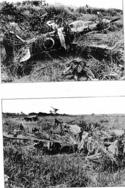| The Marines were wet and tired. The landing the day after Christmas had
been hectic. The surf was rough, the beach narrow and bordered by jungle
and swamp. Japanese air raids had inflicted little damage on the Marines
landing that day but had added to the confusion. Resistance ashore had been
light at first. The advance toward the airfield on the second day had been
hellish. There was only a narrow coastal track with swamps to the left and
bluffs and surf to the right. Pockets of Japanese resistance and small but
fierce counter-attacks were overcome with the help of tanks and firepower.
On the third day swamps gave way to jungle on the left and enveloping tactics
could be used. On the fourth day they reached the airfield. The first runway
was mainly clear open space. The Marines would have been sitting ducks had
there been heavy resistance at that point. The second runway was overgrown
with kunai grass. The Marines moved rapidly forward over the relatively
open terrain. On that day much of the airfield area was occupied. On the
last day of 1943 the American flag was raised high above the airfield.
Heavy fighting continued east and west of the airfield area of Tuluvu.
Japanese elements were also concentrating to establish new defense lines
to the south. Some Marines of the 1st and 5th Marine Regiments had the
duty to provide security for the airfield and continue to search and clear
it in the days after it was taken. Parts of the airfield were pocked with
unfilled bomb craters. Several wrecked airplanes had been discovered.
Propellers and other aircraft parts littered the area. Young Marines dirty,
tired and wet from rain and sweat came across a sight no one expected
and almost every one of them could recognize as significant. A Japanese
fighter, untouched by bombs or bullets, stood intact in the kunai grass
covered with camouflage of brush and branches.

The hidden jewel -
Type 3 fighter. |
|
